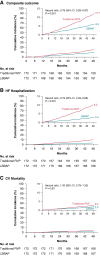Two-year outcomes of left bundle branch area pacing versus traditional right ventricular pacing in middle-aged adults: a registry-based trial
- PMID: 40880214
- PMCID: PMC12396185
- DOI: 10.1093/europace/euaf181
Two-year outcomes of left bundle branch area pacing versus traditional right ventricular pacing in middle-aged adults: a registry-based trial
Abstract
Aims: Prolonged right ventricular pacing (RVP) increases the risk of cardiomyopathy, atrial fibrillation, heart failure (HF), and mortality. This registry-based trial compared left bundle branch area pacing (LBBAP) with RVP in patients younger than 65 years.
Methods and results: Using the ConTempoRary Cardiac Stimulation in Clinical practicE: lEft, BivEntriculAr, Right, and conDuction System Pacing (TREEBEARD) registry (NCT06324682), patients were randomized 1:1 to LBBAP or RVP. The primary endpoint was a composite of cardiovascular (CV) death and HF hospitalization (HFH); secondary endpoints included individual components and all-cause mortality. A total of 344 patients (mean age 58.5 years, 215 males, 172 per arm) were included. At 2 years, the primary composite endpoint occurred in 6.3% of LBBAP vs. 12.7% of RVP patients (HR, 0.78; 95% CI, 0.59-0.87), representing a 22% risk reduction. Subgroup analyses aligned with primary findings. Left bundle branch area pacing significantly reduced HFH risk (HR, 0.79; 95% CI, 0.63-0.86) but showed no difference in CV mortality (HR, 1.02; 95% CI, 0.79-1.32) or all-cause mortality (HR, 1.00; 95% CI, 0.72-1.38).
Conclusion: Left bundle branch area pacing significantly lowered the 2-year composite of CV death and HFH compared to RVP in patients aged <65 years old. However, it did not reduce CV or all-cause mortality individually compared to RVP.
Clinical trial registration: TREEBEARD (NCT06324682).
Keywords: Cardiovascular death; Heart failure; Left bundle branch area pacing; Right ventricular pacing.
© The Author(s) 2025. Published by Oxford University Press on behalf of the European Society of Cardiology.
Conflict of interest statement
Conflict of interest: M.B. received speaker’s fees from Biotronik, Abbott, and Boston Scientific and small consultant fees from Biotronik, Boston Scientific, and Microport. L.M. received speaker’s fees from Biotronik. F.Z. received speaker fees from Abbott, Biotronik, Boston Scientific, Medtronic, and Microport. M.Z received speaker’s fees from Abbott, Biotronik, Boston Scientific, and Edwards Lifesciences. G.B. is the principal investigator of the Applying ARtificial Intelligence to define clinical trajectorieS for personalized predicTiOn and early deTEction of comorbidity and muLtimorbidity pattErnS (ARISTOTELES) project that received funding from the European Union within the Horizon 2020 research and innovation programme (grant no. 101080189). G.B. reported small speaker fees from Bayer, Boehringer Ingelheim, Boston, Daiichi Sankyo, Janssen, and Sanofi outside of the submitted work. The other authors have no conflicts of interest to disclose.
Figures




References
-
- Tops LF, Schalij MJ, Holman ER, van Erven L, van der Wall EE, Bax JJ. Right ventricular pacing can induce ventricular dyssynchrony in patients with atrial fibrillation after atrioventricular node ablation. J Am Coll Cardiol 2006;48:1642–8. - PubMed
-
- Sweeney MO, Hellkamp AS, Ellenbogen KA, Greenspon AJ, Freedman RA, Lee KL et al. Adverse effect of ventricular pacing on heart failure and atrial fibrillation among patients with normal baseline QRS duration in a clinical trial of pacemaker therapy for sinus node dysfunction. Circulation 2003;107:2932–7. - PubMed
-
- Khurshid S, Epstein AE, Verdino RJ, Lin D, Goldberg LR, Marchlinski FE et al. Incidence and predictors of right ventricular pacing-induced cardiomyopathy. Heart Rhythm 2014;11:1619–25. - PubMed
-
- Vijayaraman P, Bordachar P, Ellenbogen KA. The continued search for physiological pacing: where are we now? J Am Coll Cardiol 2017;69:3099–114. - PubMed
-
- Chen K, Li Y, Dai Y, Sun Q, Luo B, Li C et al. Comparison of electrocardiogram characteristics and pacing parameters between left bundle branch pacing and right ventricular pacing in patients receiving pacemaker therapy. Europace 2019;21:673–80. - PubMed
Publication types
MeSH terms
Associated data
LinkOut - more resources
Full Text Sources
Medical
Research Materials
Miscellaneous

